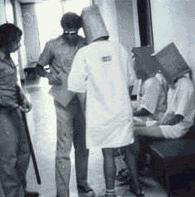– what we do to others
Artur Å»mijewski’s replay ‘repetition’ – currently shown at the Venice Biennale – follows the famous Stanford Prison Experiment and equally to the analysis he excerpts from his experiment of ‘repetition’, it draws an actual line on its website through a link of collected publications on the recent abuse of Iraqi prisoners…
| The purpose of the experiment, which consisted in isolating a group of volunteers playing the roles of inmates and guards, was to analyse two issues. First, the patterns determining how people will behave in a new situation. Second, the different perception of a given situation by people of the same background but forced to play different roles (inmates and guards). |
 |
| Professor Zimbardo’s experiment, which had been supposed to run for two weeks, had to be interrupted after just six days, as both groups started manifesting behavioural patterns normally regarded as pathological: sadism, violence, humiliation. Thirty four years later, the Stanford Prison Experiment remains a source of inspiration for psychologists, sociologists, and filmmakers alike. | |
An other experiment to find out about what we do to others is the idea behind the War Crime Documentary ‘Sympathy for the Devil’ . The three directors, Monika Borgmann, Lokman Slim, and Hermann Theissen interviewed six militiamen who were involved in the masscres of Shatila and Shabra during the cival war in Lebanon, but equally they cannot give a final answer to the occurence of dehumanizing brutality and violence …
… so finally this leads me here again to remember Susan Sonntag’s essay ‘Regarding the Torture of Others’ and eventually her book ‘The pain of others‘ (comment: the photographs of others) to recall that – despite which way an image might be interpreted – we can neither suppress nor erase or delete traumatic memory .. may be that is also the most interesting fact which gets stressed through the reference of the work ‘repetition’ by Å»mijewski’.
